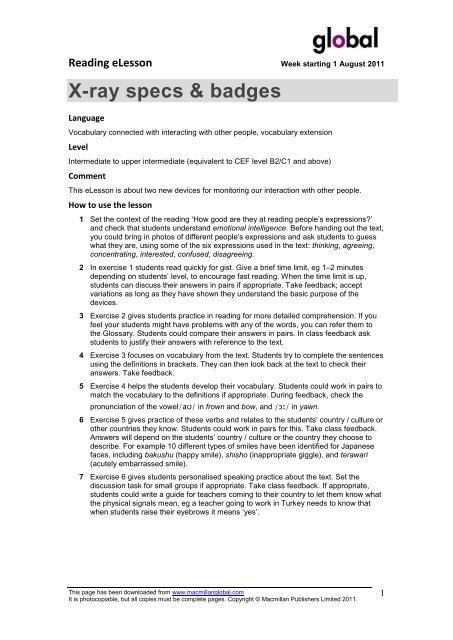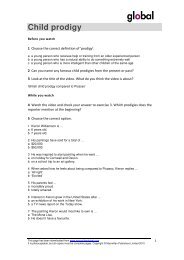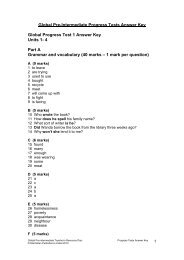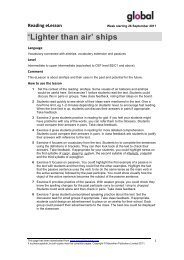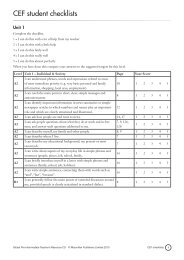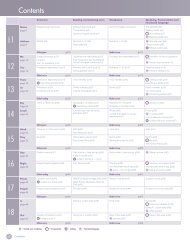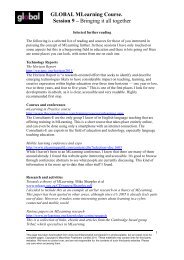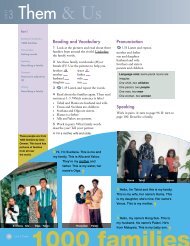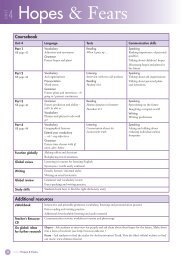Title: A visit to New York (Unit 1) - Global from Macmillan Education
Title: A visit to New York (Unit 1) - Global from Macmillan Education
Title: A visit to New York (Unit 1) - Global from Macmillan Education
You also want an ePaper? Increase the reach of your titles
YUMPU automatically turns print PDFs into web optimized ePapers that Google loves.
Reading eLesson Week starting 1 August 2011X-ray specs & badgesLanguageVocabulary connected with interacting with other people, vocabulary extensionLevelIntermediate <strong>to</strong> upper intermediate (equivalent <strong>to</strong> CEF level B2/C1 and above)CommentThis eLesson is about two new devices for moni<strong>to</strong>ring our interaction with other people.How <strong>to</strong> use the lesson1 Set the context of the reading ‘How good are they at reading people’s expressions?’and check that students understand emotional intelligence. Before handing out the text,you could bring in pho<strong>to</strong>s of different people’s expressions and ask students <strong>to</strong> guesswhat they are, using some of the six expressions used in the text: thinking, agreeing,concentrating, interested, confused, disagreeing.2 In exercise 1 students read quickly for gist. Give a brief time limit, eg 1–2 minutesdepending on students’ level, <strong>to</strong> encourage fast reading. When the time limit is up,students can discuss their answers in pairs if appropriate. Take feedback; acceptvariations as long as they have shown they understand the basic purpose of thedevices.3 Exercise 2 gives students practice in reading for more detailed comprehension. If youfeel your students might have problems with any of the words, you can refer them <strong>to</strong>the Glossary. Students could compare their answers in pairs. In class feedback askstudents <strong>to</strong> justify their answers with reference <strong>to</strong> the text.4 Exercise 3 focuses on vocabulary <strong>from</strong> the text. Students try <strong>to</strong> complete the sentencesusing the definitions in brackets. They can then look back at the text <strong>to</strong> check theiranswers. Take feedback.5 Exercise 4 helps the students develop their vocabulary. Students could work in pairs <strong>to</strong>match the vocabulary <strong>to</strong> the definitions if appropriate. During feedback, check thepronunciation of the vowel/aʊ/ in frown and bow, and /ɔː/ in yawn.6 Exercise 5 gives practice of these verbs and relates <strong>to</strong> the students’ country / culture orother countries they know. Students could work in pairs for this. Take class feedback.Answers will depend on the students’ country / culture or the country they choose <strong>to</strong>describe. For example 10 different types of smiles have been identified for Japanesefaces, including bakushu (happy smile), shisho (inappropriate giggle), and terawari(acutely embarrassed smile).7 Exercise 6 gives students personalised speaking practice about the text. Set thediscussion task for small groups if appropriate. Take class feedback. If appropriate,students could write a guide for teachers coming <strong>to</strong> their country <strong>to</strong> let them know whatthe physical signals mean, eg a teacher going <strong>to</strong> work in Turkey needs <strong>to</strong> know thatwhen students raise their eyebrows it means ‘yes’.This page has been downloaded <strong>from</strong> www.macmillanglobal.comIt is pho<strong>to</strong>copiable, but all copies must be complete pages. Copyright © <strong>Macmillan</strong> Publishers Limited 2011.1
Reading eLesson Week starting 1 August 2011Answer key1 x-ray specs show you the listener’s reaction <strong>to</strong> what you’re saying2sociometric badges show how often people speak <strong>to</strong> each other, for how long and whothey speak <strong>to</strong> most / least1 x-ray glasses2 no (we give off unconscious signals)3 nodding and squinting4 thinking, agreeing, concentrating, interested, confused, disagreeing5 with a traffic light system (displayed on the lens) with green for ‘interested’, amber for‘moderately interested’ and red for ‘not interested’6 how often you’re speaking, for how long and who with7 people8 the interaction between people (a thick line if two people speak a lot <strong>to</strong> each other and avery thin if they barely speak)9 although some of the speakers started with very different dots, by the end of theexperiment all the dots were more or less the same size and colour, which showed thatpeople had changed their behaviour and made the interaction more even31 emotional intelligence2 device3 give off4 interpret5 novelty6 barely7 transform41 f 6 a2 b 7 i3 g 8 d4 e 9 c5 h 10 j5 Students’ own answers / ideas.6 Students’ own answers / ideas.Related websitesThe following websites might be useful for either you or your students.http://www.newscientist.com/article/mg21128191.600-specs-that-see-right-throughyou.html?page=3http://www.iq.harvard.edu/news/studying_human_behavior_sociometric_badgeThis page has been downloaded <strong>from</strong> www.macmillanglobal.comIt is pho<strong>to</strong>copiable, but all copies must be complete pages. Copyright © <strong>Macmillan</strong> Publishers Limited 2011.2


